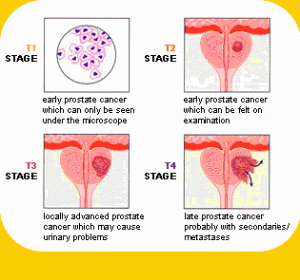The main surgery option is a radical prostatectomy, which is now often performed via keyhole surgery.
The whole prostate is removed with the seminal vesicles, the deferent canals (conducting the sperm), part of the bladder neck and the surrounding lymph nodes.
At the early localised stage (stages T1 & T2 see below), the radical prostatectomy is the reference treatment. This surgical intervention is complex (general anaesthesia for 3 to 4 hours).

Radical Prostatectomy
A radical prostatectomy is essentially the total removal of the prostate to get rid of all the cancerous cells. The operation is only done on men below the age of 70 and in those whose cancer is not thought to have spread.
This surgery does have some side effects; many men post-operation have some level of impotence, such as difficulties having and maintaining an erection, and it can also cause incontinence (problems urinating).
Doctors can’t predict who will be affected by these side effects, so you should be fully aware before undergoing this treatment. If you are worried, your doctor can suggest other possible treatment options.
Although in most cases, a radical prostatectomy gets rid of all the cancerous cells, for some men (about 1 in 3), the cancer cells may come back after the operation. If this happens, you are likely to be offered external radiotherapy.
Laparoscopic prostatectomy (keyhole surgery)
With a laparoscopic prostatectomy, your surgeon doesn’t need to make a large opening but can take out your prostate gland using only 4 or 5 minor cuts (about 1cm each) in your tummy area (abdomen).
The surgeon uses specially designed instruments that can be put through these minor cuts. This type of surgery is also known as keyhole surgery.
Sometimes, laparoscopic prostatectomy is carried out using a machine (robotic-assisted laparoscopic prostatectomy).
Instead of the surgeon and assistant moving the camera and instruments, they are attached to robotic arms. The robotic arms can move very delicately, steadily and precisely.
The machine used in robotic laparoscopic prostatectomy is called a da Vinci® machine – so this type of surgery is sometimes called the da Vinci prostatectomy.
Only a few surgeons in the UK are trained (though more are being trained) in these techniques, and there are only a few robot-assisted systems such as da Vinci®, so this treatment is not yet widely available. Your specialist can tell you if it might be appropriate for you and whether it may be available.
Most studies have shown that laparoscopic surgery and robotic-assisted laparoscopic surgery are as successful at treating prostate cancer as open surgery. Your surgeon can discuss the potential risks and benefits with you. These types of surgery are only performed by surgeons with specialised training and experience in the techniques involved.
See also PC UK.
After Effects
The significant effect of surgery is Erectile Dysfunction. No matter how good the surgeon is, there will be some nerve damage, resulting in the inability to achieve an erection. There are numerous methods to help overcome this condition. Psychosexual counselling is also worthwhile. You may try PC UK for more initial information. We have a couple of webinars giving a patient experience of his journey to cope with this condition. They are not publicly available. Use the Contact Form to enquire about them.
